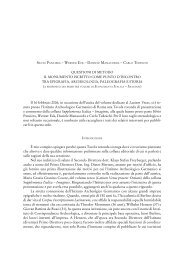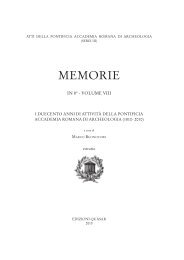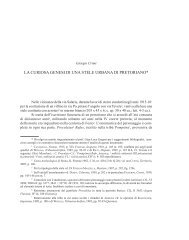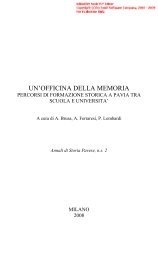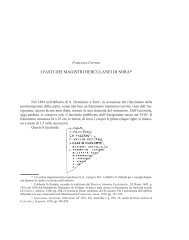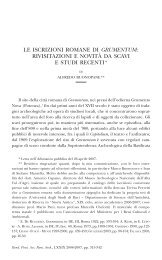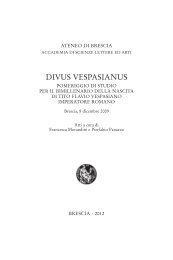There Are No cursus honorum Inscriptions. The Function of the ...
There Are No cursus honorum Inscriptions. The Function of the ...
There Are No cursus honorum Inscriptions. The Function of the ...
Create successful ePaper yourself
Turn your PDF publications into a flip-book with our unique Google optimized e-Paper software.
88 THERE ARE NO CURSUS HONORUM INSCRIPTIONS<br />
Perugia and Assisi on <strong>the</strong> river Clitumnus. From <strong>the</strong>re we have <strong>the</strong> fragment <strong>of</strong> an<br />
inscription, 35 which shows that Pliny was not content with having his benefaction<br />
mentioned in <strong>the</strong> inscription associated with <strong>the</strong> building (obviously a temple) erected<br />
<strong>the</strong>re, but had provided, probably in his testament, for his entire career to be mentioned<br />
in this inscription as well. This request was carried out, as can be inferred from <strong>the</strong><br />
fragment.<br />
A <strong>cursus</strong> <strong>honorum</strong> was nei<strong>the</strong>r a biography nor a curriculum vitae in our sense <strong>of</strong> <strong>the</strong><br />
word, although this term is <strong>of</strong>ten used to describe it. <strong>The</strong> <strong>cursus</strong> <strong>honorum</strong>, as <strong>the</strong> two<br />
words making up <strong>the</strong> phrase imply, was restricted to <strong>the</strong> performance <strong>of</strong> public functions.<br />
Strictly personal elements were totally absent. <strong>The</strong> <strong>cursus</strong> <strong>honorum</strong> was meant to show<br />
what was done for <strong>the</strong> res publica and in its service. It is <strong>the</strong>refore not surprising that <strong>the</strong><br />
concept <strong>of</strong> <strong>cursus</strong> <strong>honorum</strong> in republican times was relevant only for members <strong>of</strong> <strong>the</strong><br />
senate, those who were elected to serve as magistrates. <strong>No</strong>r is it surprising that for many<br />
centuries before Augustus, a full <strong>cursus</strong> <strong>honorum</strong> appeared only on funerary inscriptions.<br />
In this respect too our records convey a true reflection <strong>of</strong> reality: a <strong>cursus</strong> <strong>honorum</strong> was<br />
an adaptation <strong>of</strong> <strong>the</strong> laudatio funebris in epigraphic form, and <strong>the</strong>refore used only for <strong>the</strong><br />
dead. 36 When a life was over, when service for <strong>the</strong> res publica was completed, <strong>the</strong><br />
achievements <strong>of</strong> an individual could be measured, and even balanced, in comparison and<br />
in competition with o<strong>the</strong>r members <strong>of</strong> <strong>the</strong> ruling class. 37<br />
At <strong>the</strong> very end <strong>of</strong> <strong>the</strong> republican period, but more probably only since Augustan<br />
times, this form <strong>of</strong> summing up a life which had come to an end was transferred from <strong>the</strong><br />
dead to <strong>the</strong> living, and not as stock-taking, a balance sheet to be produced by those<br />
already at <strong>the</strong> end <strong>of</strong> <strong>the</strong>ir senatorial career, but on <strong>the</strong> contrary, <strong>the</strong> form was taken up<br />
by those still in <strong>the</strong>ir prime, in <strong>the</strong> midst <strong>of</strong> <strong>the</strong>ir activity. <strong>The</strong> contribution <strong>of</strong> a life not<br />
yet finished may already be accepted as a <strong>cursus</strong>. <strong>The</strong> building inscription <strong>of</strong> <strong>the</strong> Minicii<br />
Natales mentioned <strong>the</strong> <strong>cursus</strong> <strong>of</strong> <strong>the</strong> son only up to <strong>the</strong> point that he became tribune <strong>of</strong><br />
<strong>the</strong> plebs. 38<br />
More important, however, was <strong>the</strong> extension <strong>of</strong> this form to people who never<br />
received a public commission, an assignment from <strong>the</strong> people, in <strong>the</strong> strict sense <strong>of</strong> <strong>the</strong><br />
word — that is, by election. This epigraphic form was very quickly picked up by senior<br />
functionaries appointed by a single person, especially by <strong>the</strong> Princeps. We find it already<br />
35 CIL XI 5272 = AE 1999, 612 (Hispellum): [G(aius) Plinius L(uci) f(ilius) Ouf(entina)<br />
Caecilius Secundus co(n)s(ul) augur] [Xvir stlit(ibus) iudicand(is) trib(unus) mil(itum)<br />
leg(ionis) III Galli]ca[e] [sevir eq(uitum) R(omanorum) quaestor Imperatori]s trib(unus)<br />
plebis pr(aetor) [praef(ectus) aer(arii) milit(aris) praef(ectus) aer(arii) Saturni cur(ator)<br />
alvei] Tiberis ex s(enatus) c(onsulto) pro[consulari potestate legatus pr(o) pr(aetore)<br />
provinciae Ponti] et Bithyniae et legatus [in eam ab Imp(eratore) Caes(are) Nerva Traiano<br />
Aug(usto) missus testame]nto [fieri] iussit.<br />
36 W. Eck, ‘Senatorial Self-Representation: Developments in <strong>the</strong> Augustan Period’, in: Caesar<br />
Augustus. Seven Aspects, eds. F. Millar and E. Segal, Oxford 1984, 129 ff., esp. 133 ff.<br />
37 Compare also S. Panciera, ‘L’epigrafia Latina nell’ passaggio dalla repubblica all’ impero’,<br />
in: Idem, Epigrafi, epigrafia, epigrafisti, Rome 2006, Vol. I, 83 ff.<br />
38 See above p. 82.



